Comparing iPhone 12 and iPhone 11 Dimensions: An In-Depth Look
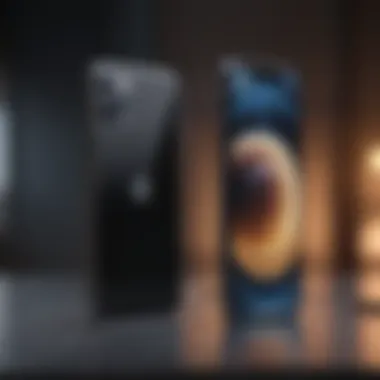
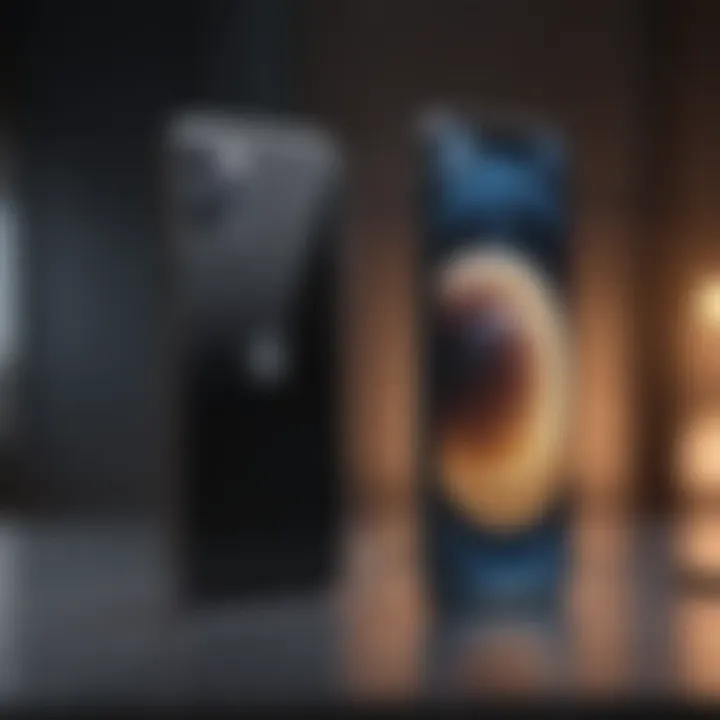
Intro
In the evolving landscape of smartphones, dimensions play a crucial role in user experience and preference. The iPhone 12 and iPhone 11 stand out not just for their advanced features but also for their distinct sizes. This article embarks on a comparative analysis, delving into the specifics of each model's dimensions, including height, width, depth, and weight. By understanding these facets, consumers can grasp how the variations may affect their daily use and comfort when handling these devices.
Overview of Dimensions
Height, Width, Depth, and Weight
The dimensions of a smartphone contribute significantly to how it feels in the hand and fits in pockets or bags. Here, we examine the measures of both the iPhone 12 and iPhone 11:
- iPhone 11:
- iPhone 12:
- Height: 150.9 mm
- Width: 75.7 mm
- Depth: 8.3 mm
- Weight: 194 grams
- Height: 146.7 mm
- Width: 71.5 mm
- Depth: 7.4 mm
- Weight: 164 grams
Despite having similar screen sizes, the iPhone 12 is slimmer and lighter than its predecessor, which might be a factor for consumers prioritizing portability.
"The slim, light design of the iPhone 12 may influence decisions for users who value manageability over larger sizes."
User Experience Implications
The difference in dimensions can lead to varied user experiences. A lighter phone like the iPhone 12 can reduce hand fatigue during extended use, especially for tasks like texting or gaming. Meanwhile, the slightly larger build of the iPhone 11 may offer a bit more surface area for typing or browsing. It can be beneficial to compare how each model feels physically.
Design Evolution
The design language also reflects in the dimensions of each device. The iPhone 11 maintains a rounded finish, creating a softer profile, while the iPhone 12 features squared edges. This change not only impacts aesthetics but also ergonomics. Leveraging a different grip method can be more comfortable for some users, while others might prefer the cozy feel of the iPhone 11.
Screen Size Specifications
Both models offer impressive display technology but differ slightly in resolution:
- iPhone 11 has a resolution of 1792 x 828 pixels.
- iPhone 12 offers a resolution of 2532 x 1170 pixels.
This higher resolution in the iPhone 12 results in a sharper image quality. However, how one perceives this quality may also depend on the physical dimensions of the device in hand.
Epilogue
Understanding the nuanced differences in dimensions between the iPhone 12 and iPhone 11 assists potential buyers in making a more informed decision. The size, weight, and design can influence daily interactions and comfort levels based on personal preferences. As consumers weigh their options, they should consider factors beyond features and specifications, contemplating how a device feels while in use.
Intro to iPhone Size Comparisons
Understanding the dimensions of smartphones is crucial for both existing users and potential buyers. The size of a phone has a direct impact on usability, ergonomics, and overall user experience. This analysis foregrounds the significance of comparing the iPhone 12 and iPhone 11 dimensions. Knowing the numerical specifications can guide consumers in making informed choices, particularly when selecting a phone that complements their daily routines and preferences.
Why Size Matters in Smartphone Selection
The dimensions of a smartphone influence how it feels in the hand, how easy it is to navigate the interface, and even how portable it is. A larger phone may offer a bigger screen but can be cumbersome for one-handed use. Conversely, smaller phones may be easier to grip but can constrain the visual experience. When purchasing, factors such as screen size, weight, and thickness play a key role in user satisfaction. These dimensions affect not only aesthetics but also functionality, making it essential for consumers to consider how a phone fits into their lifestyle.
Overview of iPhone Models
The iPhone 11 and iPhone 12 represent significant iterations in Apple's lineup, both in terms of design and technology. The iPhone 11, launched in 2019, is known for its rounded edges and robust build quality, while the iPhone 12, released in 2020, introduced a more angular aesthetic and a redesign that many found appealing. Each model offers distinct advantages based on its dimensions and design philosophy.
- iPhone 11: Features a height of 150.9 mm, a width of 75.7 mm, and a depth of 8.3 mm. Its weight is approximately 194 grams. This model caters to users who prefer a more substantial feel.
- iPhone 12: Is slightly taller at 146.7 mm, with a width of 71.5 mm and a thinner depth of 7.4 mm. It has a lighter weight of about 164 grams, making it feel less bulky in the hand.
This overview establishes a foundation for further exploration into the physical dimensions of both devices, setting the stage for a detailed comparison.
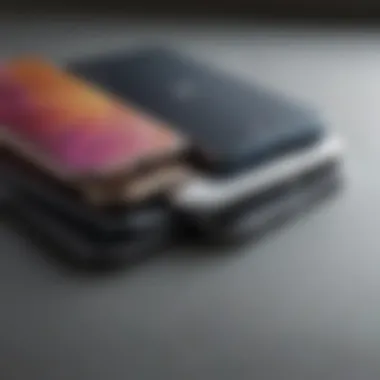

Physical Dimensions of iPhone
The physical dimensions of the iPhone 11 are critical for understanding how this device fits into the broader iPhone lineup. Consumers often prioritize size in their selection process, with considerations relating to the ease of handling, portability, and overall user experience.
When assessing smartphones, awareness of height, width, depth, and weight can greatly influence a buyer's decision. This section provides a clear breakdown of the iPhone 11's dimensions, which can offer insights into its usability compared to other models.
Height and Width Specifications
The height and width of the iPhone 11 are significant metrics in evaluating its physical presence. The iPhone 11 measures approximately 150.9 mm in height and 75.7 mm in width. These dimensions contribute to a balanced feel in one’s hand, ensuring that the device is neither too big nor overly compact.
A device with a height of 150.9 mm appeals to users who appreciate a substantial screen area while maintaining a level of comfort during extended use. The width, at 75.7 mm, offers a grip that feels secure, making it easier to navigate text and images with one hand.
In comparison to its predecessor, the iPhone 11 maintains a familiar feel for long-time users. Such specifications are important as they affect how one interacts with the device during daily tasks, like texting or browsing.
Depth and Weight Characteristics
The depth and weight of the iPhone 11 are equally worth assessing. The device features a depth of about 8.3 mm and weighs approximately 194 grams. This combination results in a solid yet manageable structure.
The device's heft can influence user comfort, especially when held for prolonged periods. Weighing in at 194 grams, the iPhone 11 is seen as a balance between sturdiness and portability. It is not so light that it feels fragile, nor so heavy that it becomes unwieldy.
Physical Dimensions of iPhone
The physical dimensions of the iPhone 12 hold significant importance for potential buyers. When comparing smartphones, size is one of the most critical elements that influences user experience. The iPhone 12 was designed with specific measurements that aim to improve ergonomics while accommodating new technological advancements.
Understanding the dimensions helps users assess how the device will fit in their hands, pockets, or bags. Size affects portability, usability, and even aesthetics. Given the increasing trend towards larger screens, the iPhone 12's dimensions reflect a balance between display area and ease of handling.
Height and Width Specifications
The height and width of the iPhone 12 are notable factors that set it apart from the previous model, the iPhone 11. The iPhone 12 measures 146.7 mm in height and 71.5 mm in width. This measurement provides users with a wider screen but maintains a comfortable feel for one-handed use.
In contrast, the iPhone 11 has a similar height of 150.9 mm but is slightly wider at 75.7 mm. Users may find that the narrower width of the iPhone 12 allows for easier handling and navigation, particularly during prolonged use.
The choice of dimensions in the iPhone 12 results from extensive user feedback and market research, suggesting a preference for models that facilitate comfortable handling without sacrificing screen real estate.
Depth and Weight Characteristics
Examining the depth and weight of the iPhone 12 is equally essential. The iPhone 12 has a depth of 7.4 mm and weighs 164 grams. These specifications make the device lighter than the iPhone 11, which weighs 194 grams and has a depth of 8.3 mm.
The reduced weight of the iPhone 12 enhances portability, allowing users to carry it for longer durations without fatigue. The slimness of the iPhone 12 also contributes to a sleeker look while maintaining durability.
"The compactness of the iPhone 12 emphasizes its stylish nature and practical use cases for various demographics."
For young professionals and families, lighter and slimmer devices can lead to a more convenient day-to-day experience. The lighter heft might also be appealing to students who often carry their devices around for extended periods.
In summary, the combination of height, width, depth, and weight in the iPhone 12 plays a key role in defining user experience. Buyers can use these specifications to inform their decision-making process effectively.
Comparison of Dimensions
The importance of dimension comparison between the iPhone 12 and iPhone 11 cannot be overstated. Dimensions influence not only the aesthetics of a phone but also its user experience and functionality. Understanding these differences allows consumers to make informed choices aligned with their preferences and needs. Factors like height, width, depth, and weight all contribute to how a phone feels in hand, how it fits in pockets, and how comfortably it can be used for extended periods.
Direct Size Comparisons
Height Comparison
When discussing height, it is vital to note that the iPhone 12 stands at 6.1 inches, while the iPhone 11 shares the same height. This similarity means that potential buyers will not have to adjust to a different hand feel if switching from one model to another. The consistent height allows for easy one-handed operation, enabling users to reach the top of the screen without significant adjustments.
However, subtle design differences exist in how the edges of the two models taper. The iPhone 12 has flat edges compared to the rounded edges of the iPhone 11, leading to a different grip feel. This feature can have ergonomic implications, making the iPhone 12 feel more secure in the hand for some users while potentially causing discomfort for others designed for the rounded edges of the 11.


Width Comparison
In terms of width, the iPhone 12 is 2.82 inches wide while the iPhone 11 is slightly wider at 2.98 inches. The narrower width of the iPhone 12 can enhance usability. Users with smaller hands might find it easier to manage the device for tasks such as texting or browsing, as it offers a smaller profile overall. However, the wider frame of the iPhone 11 provides an added surface area that some users may prefer, as it may feel more stable when held.
This choice comes down to personal preference. An advantage of the iPhone 11's broader build is the potentially more comfortable hold for prolonged usage. In contrast, the iPhone 12's slim design can make it more appealing for those prioritizing portability.
Depth Comparison
Analyzing depth reveals that the iPhone 12 has a slim profile of 0.29 inches compared to the slightly thicker 0.32 inches of the iPhone 11. This reduction in thickness for the iPhone 12 contributes to an overall sleeker feel. The slimmer design allows for easier sliding into a pocket or purse, enhancing its portability.
Despite this thinner design, the slight increase in thickness of the iPhone 11 offers a well-rounded hand-feel. Users who prefer a more substantial device might find the iPhone 11 appealing. In general, the depth plays a crucial role in making the device sit comfortably in the user's grip.
Weight Comparison
Weight is an important factor, especially for those who carry their phones throughout the day. The iPhone 12 weighs 164 grams, while the iPhone 11 is slightly heavier at 194 grams. This weight difference matters particularly for users sensitive to heft in their pockets or hands. The lighter build of the iPhone 12 can reduce fatigue during long usage periods.
On the other hand, some users might detect the difference in weight as a feeling of durability. The iPhone 11's weight can suggest sturdiness which certain users may prefer, though this is subjective. Ultimately, for users on the go, the iPhone 12's lighter weight might be more desirable.
Impact on Handling and Ergonomics
Understanding handling and ergonomics is crucial in choosing between these two models. Ergonomics relates to how the design of these devices affects user comfort and usability. Notably, the differences in dimensions can lead to significant variations in user experience when it comes to daily tasks such as texting, calling, and gaming.
For those who frequently engage with their phones one-handed, the combined factors of height and width can make a marked difference. Users who value compactness may find the iPhone 12 preferable due to its narrower width and lighter weight, whereas those who enjoy a robust hold may favor the iPhone 11.
Design Evolution: A Closer Look
The design evolution of smartphones plays a critical role in how users perceive functionality and aesthetic appeal. The iPhone 12 and iPhone 11 are no exceptions to this rule. Understanding the nuances of their design changes may guide potential buyers in making informed choices. Factors such as aesthetic enhancements, material upgrades, and overall build quality contribute significantly to user satisfaction and can influence their decision to upgrade or choose one over the other.
Changes in Aesthetic Design
The shift in aesthetic design from iPhone 11 to iPhone 12 is notable. Apple has moved from the rounded edges of iPhone 11 to the more angular, flat-edge design of the iPhone 12. This change enhances the phone's grip, presenting a modern vibe. The new design reflects current trends in technology, showing Apple's adaptability to consumer preferences.
- Key visual upgrades include:
- Flat edges promote a contemporary look.
- Increased available color options provide personalization.
- Minimalistic element adds to device sophistication.
The iPhone 12’s design not only makes it more visually appealing but also improves durability. The ceramic shield front cover enhances screen protection, a consideration important for active users. Overall, the aesthetic evolution between these two models reflects Apple's intent to stay relevant in a competitive market while boosting user experience.
Material and Build Quality Comparisons
Examining the material and build quality of iPhone 12 versus iPhone 11 reveals significant enhancements. The iPhone 12 employs a new aluminum frame and a ceramic shield front, promising improved durability and resistance to scratches and drops. This shift results in a stronger, more resilient device that appeals to users worried about longevity.
In contrast, the iPhone 11, though well-built, uses a different material composition that does not offer the same level of protection. Users have noted that while the iPhone 11 is sturdy, the iPhone 12’s construction offers a noticeable improvement. Points of comparison include:
- Materials Used:
- Build Quality:
- iPhone 12: Ceramic shield front, aerospace-grade aluminum.
- iPhone 11: Glass front and back, aerospace-grade aluminum.
- iPhone 12: Enhanced resistance to drop impacts.
- iPhone 11: Solid construction, but less resistant to scratches.
The idea of durability continues to matter as smartphones evolve. Users prioritize devices that can withstand everyday wear and tear. This critical distinction in material choice between iPhone 11 and iPhone 12 may influence a buyer's decision, especially for those who wish to retain their smartphones for extended periods.
“In a fast-paced world, durability alongside design is indispensable. Users now look not just for style but substance.”
Thus, the evolution of design between these iPhone models serves as an important discussion point for consumers. Their decisions are likely influenced by a blend of aesthetic appeal and practical considerations, which both models strive to achieve in distinct ways.
Screen Size and Display Technology
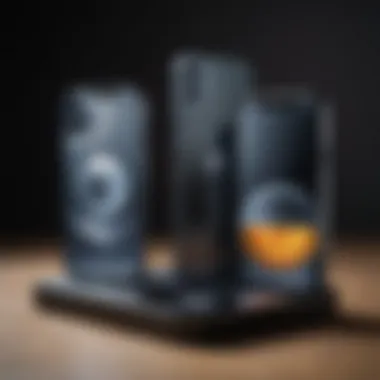
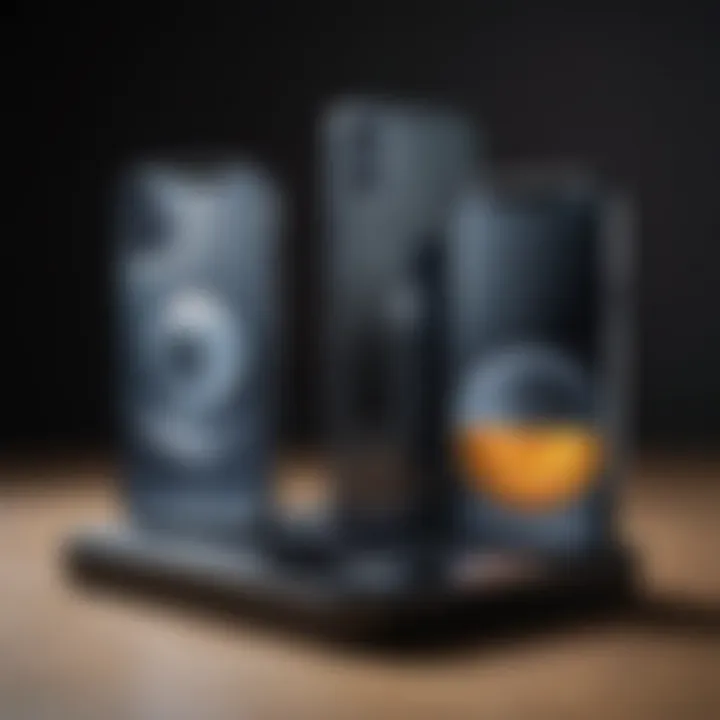
Screen size and display technology are crucial factors when comparing the iPhone 12 and iPhone 11. In today’s digital age, consumer expectations on mobile devices have shifted towards superior visual experiences. Larger screen sizes facilitate better readability, gaming experiences, and multimedia consumption. Furthermore, the technology behind these displays can greatly enhance the quality and functionality of the smartphone.
Screen Size Specifications
The iPhone 11 features a 6.1-inch Liquid Retina HD display. This display uses LCD technology, which, while vibrant, does not provide the same color depth as some more advanced technologies. On the other hand, the iPhone 12 maintains the same physical screen size but transitions to a Super Retina XDR display. This utilization of OLED technology allows for deeper blacks and higher contrast ratios. The exact specifications include:
- iPhone 11: 6.1 inches, 1792 x 828 pixels, LCD
- iPhone 12: 6.1 inches, 2532 x 1170 pixels, OLED
The difference in display type and resolution is significant. For individuals who prioritize sharp visuals, the iPhone 12 provides clearer graphics, ideal for video streaming and gaming. This may impact decisions for those looking to use their phone extensively for visual content.
Visual Experience Comparison
The visual experience between these two models can be vividly felt. Users have reported that the iPhone 12's OLED screen is much more effective in outdoor conditions, offering enhanced brightness levels. The colors on the OLED display appear more vibrant and true to life. Moreover, the improved color accuracy makes a noticeable difference in tasks such as photo editing.
A survey of user feedback reveals:
- Color vibrancy: iPhone 12 users report a richer color spectrum.
- Brightness in sunlight: Enhanced brightness in the iPhone 12 significantly enhances usability.
- Viewing angles: OLED technology provides better viewing angles, making it easier for multiple users to watch content.
“The step from LCD to OLED is not just an incremental change; it’s a leap towards an immersive viewing experience.”
In summary, the advancement in screen size and display technology between the iPhone 12 and iPhone 11 is evident. For consumers, understanding these differences is essential in making an informed decision that aligns with their multimedia needs and overall smartphone usage.
User Experience and Practical Implications
User experience is a crucial element when it comes to smartphone selection. Dimensions and weight significantly influence how users interact with their devices. In this section, we elaborate on the importance of understanding how the variations in dimensions between the iPhone 11 and iPhone 12 can affect everyday use.
Feedback from Users on Size Preferences
Users often share their thoughts about the sizes of smartphones through reviews and discussions. Feedback from current iPhone 11 and iPhone 12 users reveals various preferences.
- Some users find the iPhone 11's dimensions comfortable for one-handed use. They express that the weight balances well for extended holding.
- In contrast, a number of iPhone 12 users appreciate the slight increase in size, believing it enhances the viewing experience. The edge-to-edge display is frequently mentioned as a factor that contributes to this positive feedback.
However, not all users are aligned. For instance, individuals with smaller hands may struggle with the iPhone 12. The feedback demonstrates a split perception on size; comfort varies across user demographics.
Use Case Analysis for Different Audiences
Consideration of user demographics is vital when assessing how dimensions affect practical usage. Different groups have distinct needs, which may influence their choice between iPhone 11 and iPhone 12.
- Young professionals may prioritize portability and efficient handling. They often prefer devices that fit quickly into pockets or can be operated one-handed during commutes.
- Families, especially those with children, might focus on durability. Families also may prefer larger screens for sharing content. Thus, they may lean towards the iPhone 12 for reasons related to the larger display size and advanced features.
- Students frequently juggle several tasks, making weight and portability crucial. Many students survey the trade-offs between a slightly heavier device and the benefits of a larger, clearer screen for studying.
Each group’s perspective emphasizes the interplay between design, size, and the actual user experience. When potential buyers weigh their choices, such as whether to choose the iPhone 11 or the iPhone 12, these considerations strongly capture their priorities.
"The size of your smartphone should match not just your preferences, but also your lifestyle."
Ending: Making an Informed Decision
The conclusion of this article is important because it wraps up the insights and findings discussed throughout. Understanding the differences in dimensions between the iPhone 12 and iPhone 11 can play a crucial role in the decision-making process for potential buyers.
Summarizing Key Findings
This analysis has illustrated several key points:
- Height, Width, and Depth: The iPhone 12 features slightly different dimensions than the iPhone 11. While the differences may not seem significant, they can impact how a user feels when holding the devices.
- Weight Considerations: The weight variations can influence portability and ease of use during everyday tasks.
- Ergonomics: Subtle design choices can enhance user comfort. The way a phone fits in hand affects usability, especially for prolonged periods.
Potential buyers need to reflect on how these findings align with their personal preferences and usage habits. For example, those who prioritize compactness may find the iPhone 12's design beneficial.
Final Considerations for Potential Buyers
When deciding between these two models, it is essential to keep several factors in consideration:
- Prioritizing Features: Apart from dimensions, consider features such as camera quality, battery life, and display technology, as these are also critical in the overall user experience.
- Budget: Pricing can vary between the two models. Analyze your budget carefully, as both devices offer unique capabilities worth the investment.
- Read Reviews: Engaging with user feedback can provide insight into how dimensions translate into real-world usage. Resources like reddit.com can be helpful for this.
In summary, making an informed decision on which iPhone to choose, based on comprehensive analysis of dimensions and features, can greatly enhance the satisfaction of users. Having weighed all aspects, buyers can feel confident in their choice, ensuring it meets their everyday needs.



